Crisp light batter and perfectly tender aubergine are a match made in heaven in this Eggplant Tempura recipe!

I love tempura! It's an easy way to make the humblest ingredient into a moreish treat!
The batter gets its light crispness from the combination of carbonated water and cornflour. The chilled water adds extra air and lightness, while the starch from the cornflour helps form a layer of popped starch granules that make a super crispy battered coating.
You can make tempura with any meat, fish or vegetables - but I especially love using eggplant (aka aubergine).
Eggplant is perfect for tempura because it becomes super tender when cooked in the batter. Plus, eggplant makes an excellent slippery sponge for soaking up soy sauce or rice vinegar!
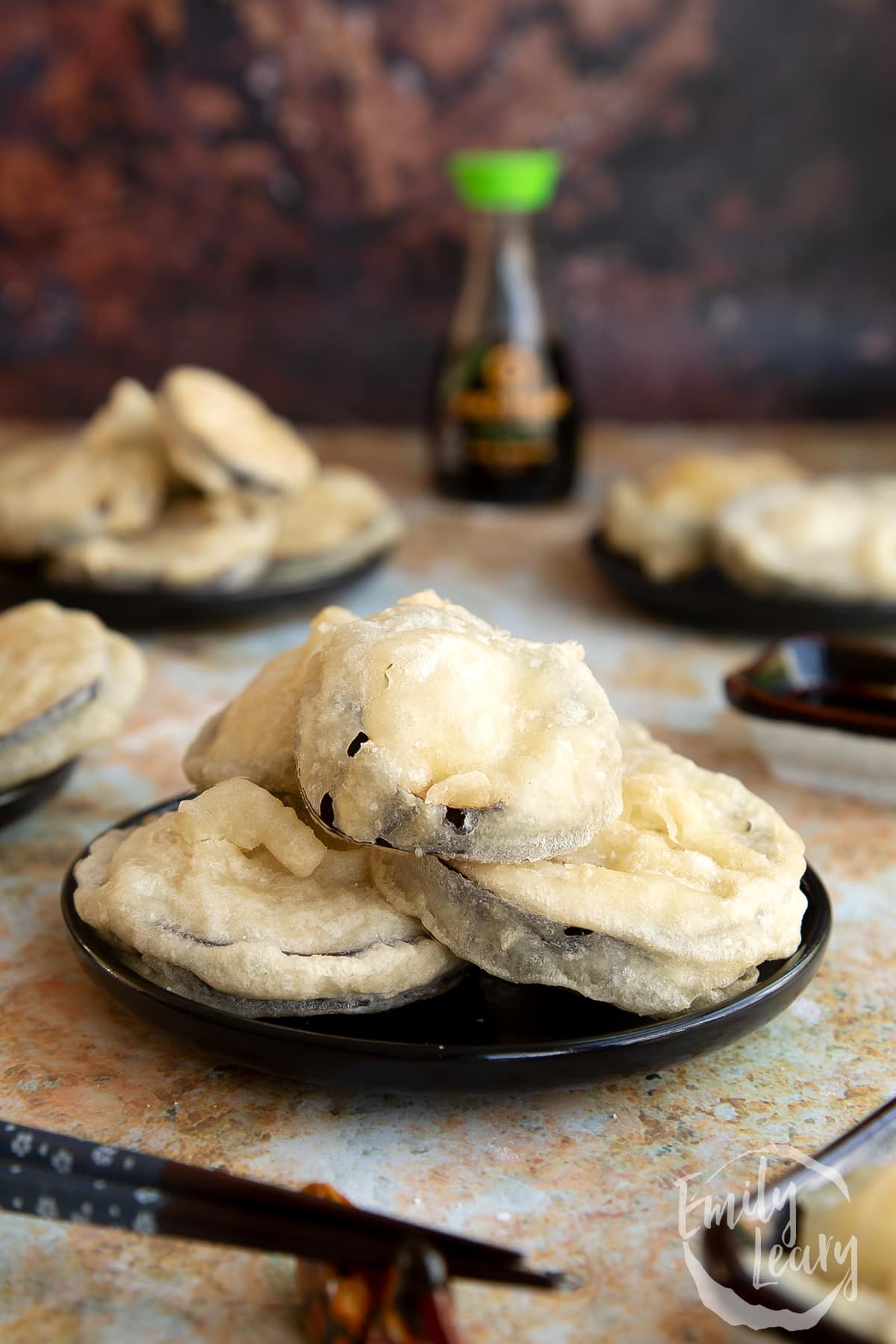
The most important thing to remember about this Eggplant Tempura recipe is you need to work with speed. The longer you leave your batter, the warmer it gets and the less air there will be in it, so get organised so that you can work efficiently.
As soon as you've mixed your batter ingredients (plain flour, cornflour, chilled fizzy water and an egg yolk), you'll plunge the of your aubergine slices into it. Make sure to only add a couple of slices at a time to avoid adding extra liquid to the batter.
As soon as they're coated, you'll drop your batter coated eggplant discs into preheated oil and cook until super light and crispy and taking on just a touch of colour.
Once your Eggplant Tempura is cooked, you'll let them drain on some kitchen towel, sprinkle them with salt and serve.
They're the perfect accompaniment to sushi or a starter before a big bowl of ramen. Plus, I find that serving tempura with dishes that you can prepare ahead (like sushi or ramen) makes the cooking experience less stressful.
However you serve them, you won't regret trying this tempura recipe! It's low effort, takes a few minutes and gives you a truly special starter or side for your meal.
The full instructions are below, with clear pictures so you can see how the batter should look as you go along. Enjoy!
Ingredients
- 2 eggplants (aubergine) cut into 2cm (1/2 inch) slices
- 100 g plain white flour (all purpose flour)
- 100 g cornflour (cornstarch)
- pinch salt
- 1 medium free range egg yolk chilled
- 200 ml fizzy water chilled
- vegetable oil to fry
Equipment
- Deep fat fryer or suitable high-sided saucepan or suitably large, high-sided saucepan
Instructions
Your fizzy water needs to be icy cold, so either chill it in a container in the refrigerator overnight, or pop a container in freezer while you get organised.
Fill your deep fat fryer (or a suitably large and high-sided saucepan) to one third full with oil. It's important not to overfill your fryer as oil expands when heated and can bubble up further when food is added. Heat to 180C (355F). Keep your oil supervised at all times.
Get your eggplant / aubergine sliced into discs so that they're on hand to use as soon as your batter is ready, cover so that they don't brown.
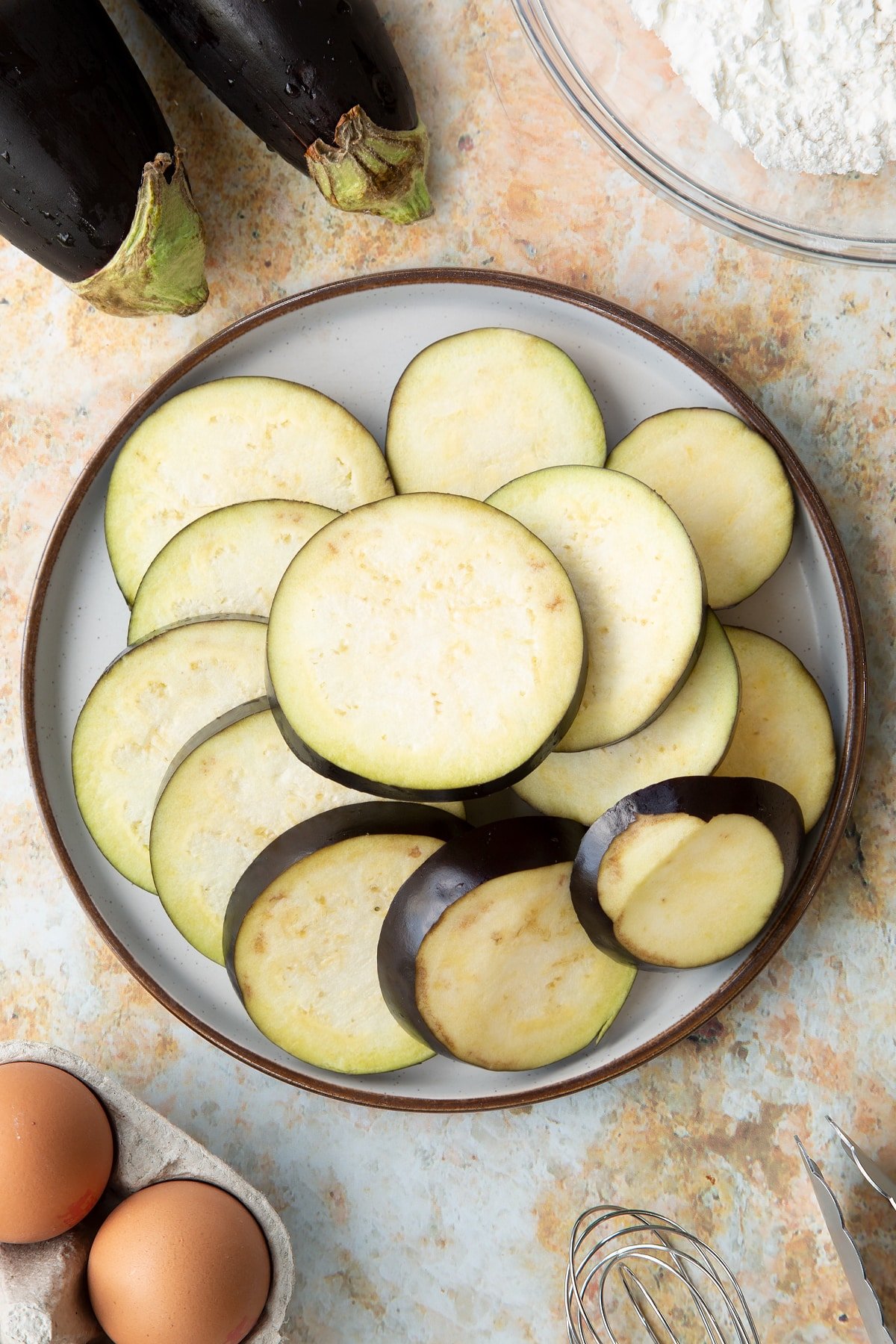
Put the flour, cornflour and a pinch of salt in a bowl.
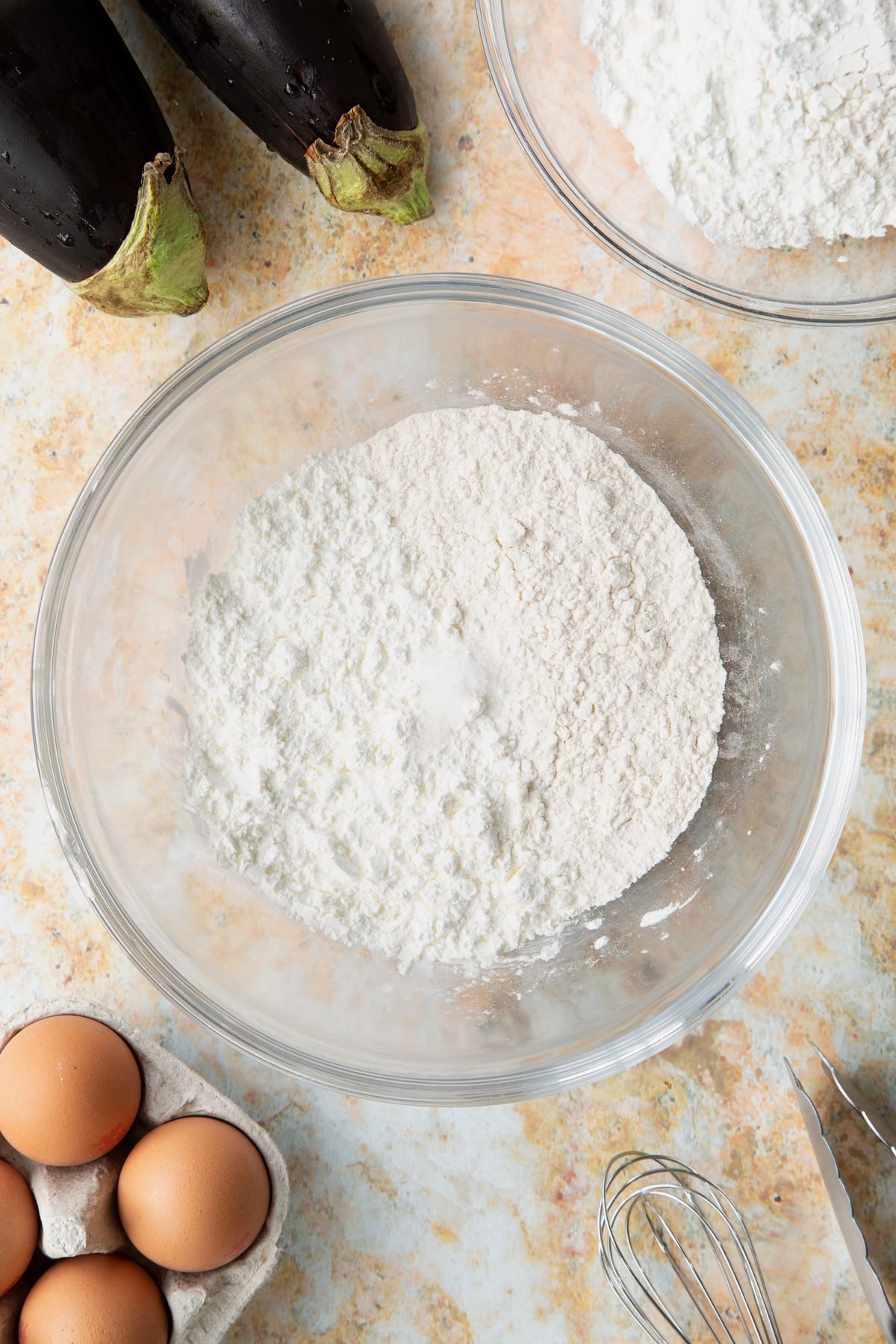
Mix together.
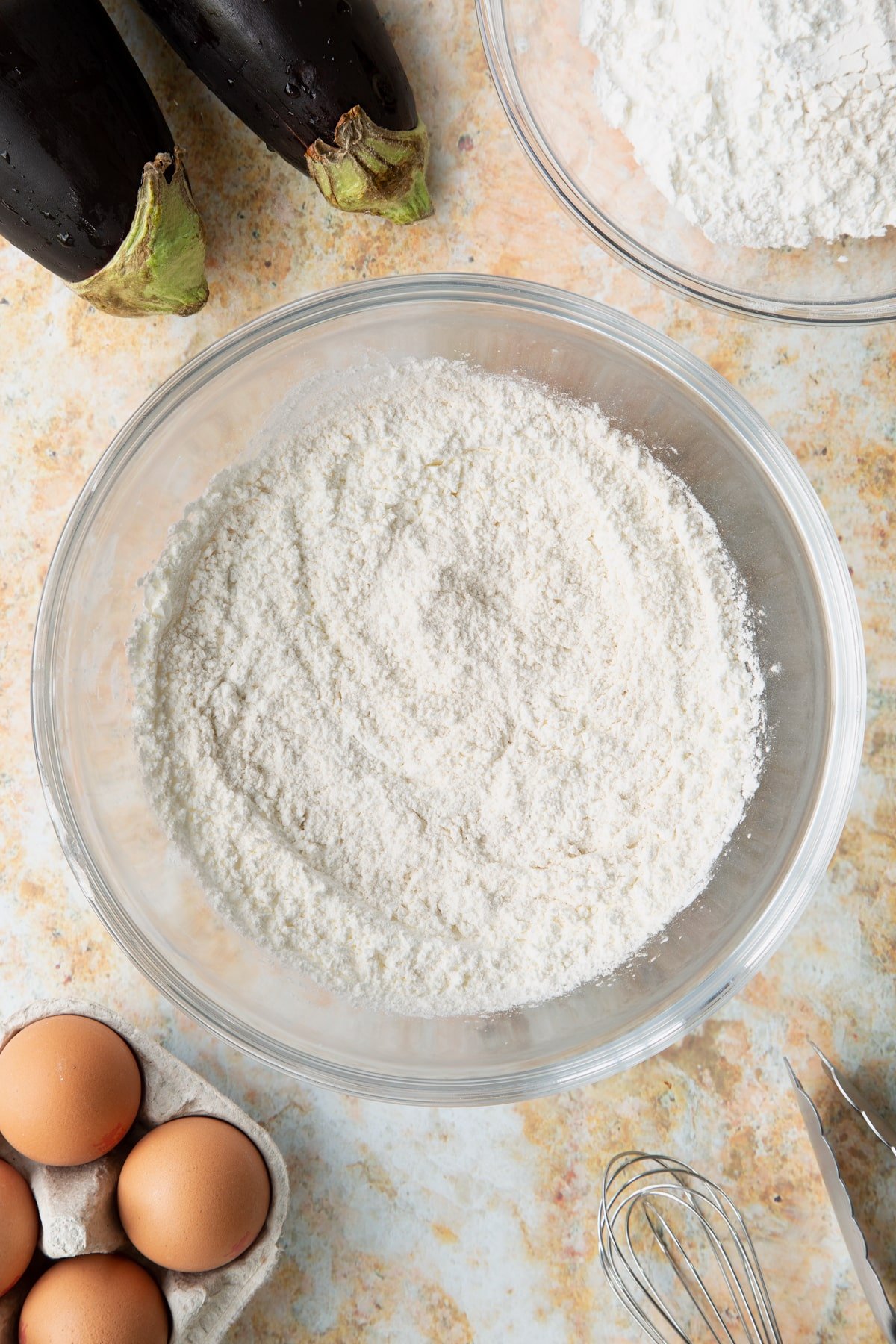
Add the egg yolk and chilled fizzy water.
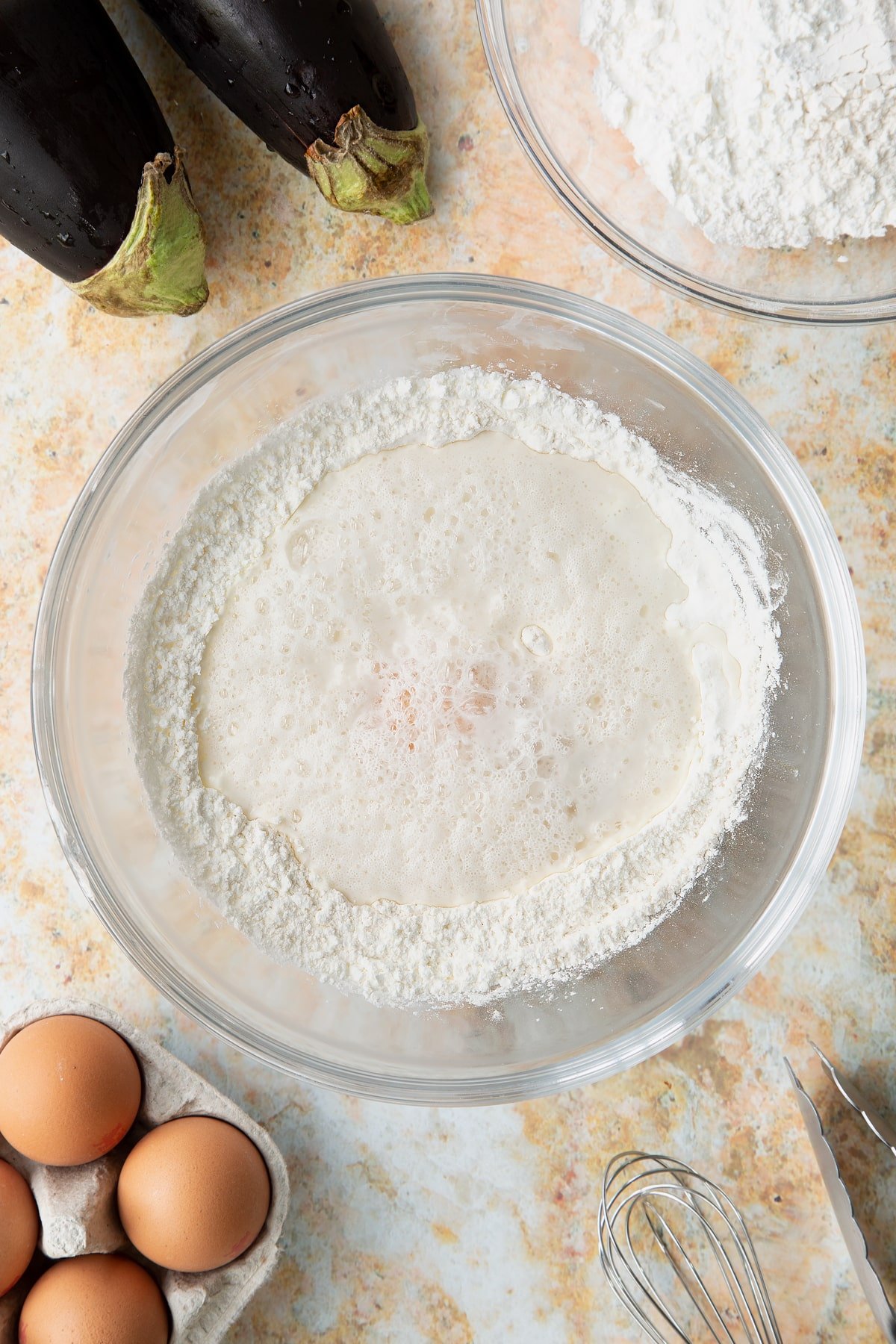
Whisk until you have a smooth batter. Whisking in one direction only can help avoid lumps.

Drop a few pieces of eggplant / aubergine into the batter.
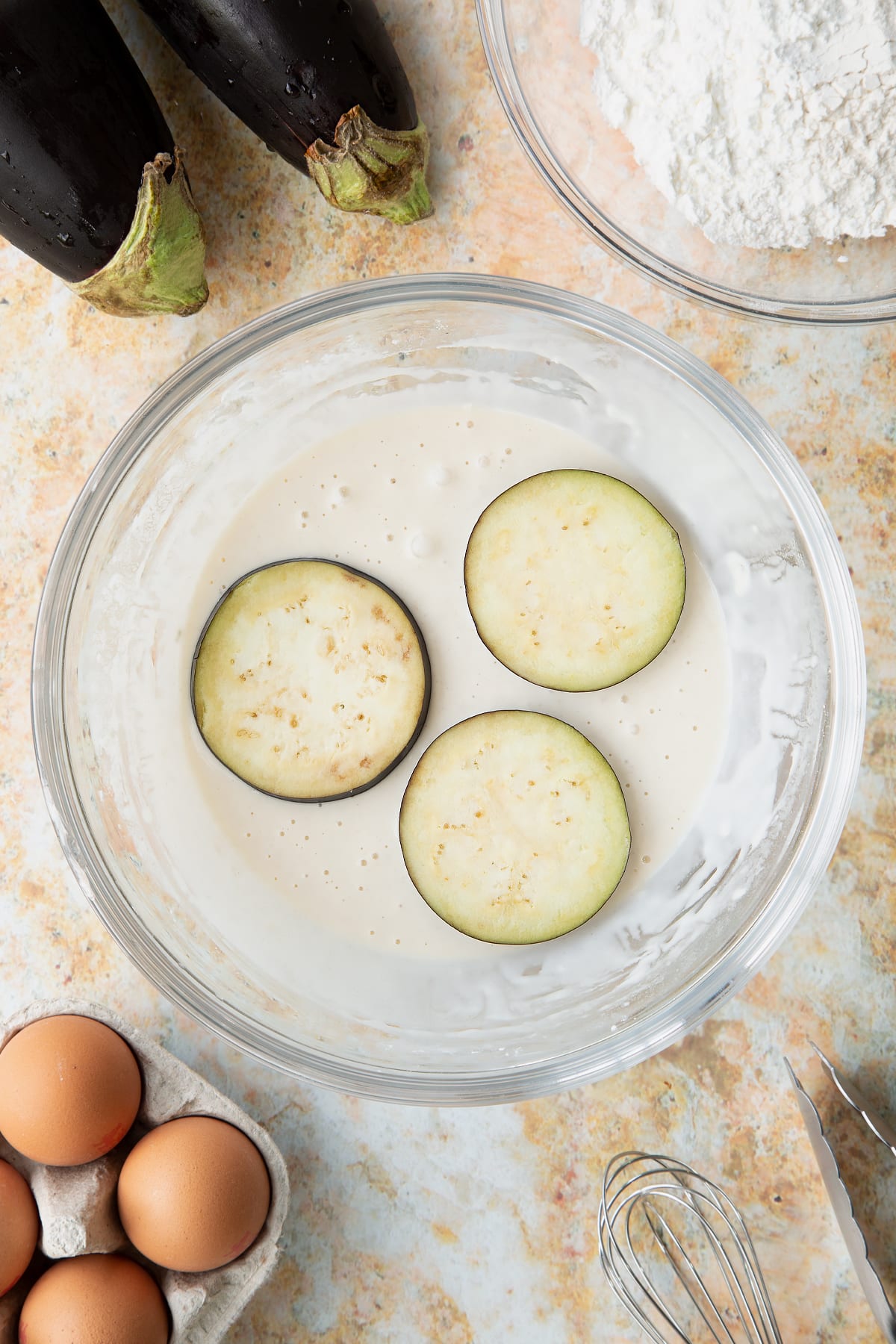
Make sure to coat all over, then lower straight into the oil. Don’t drop all the veggies into the batter at once as they can change the temperature and thickness of the batter if they sit in it too long. You also need to work in batches so that you don’t overcrowd the frying pan.
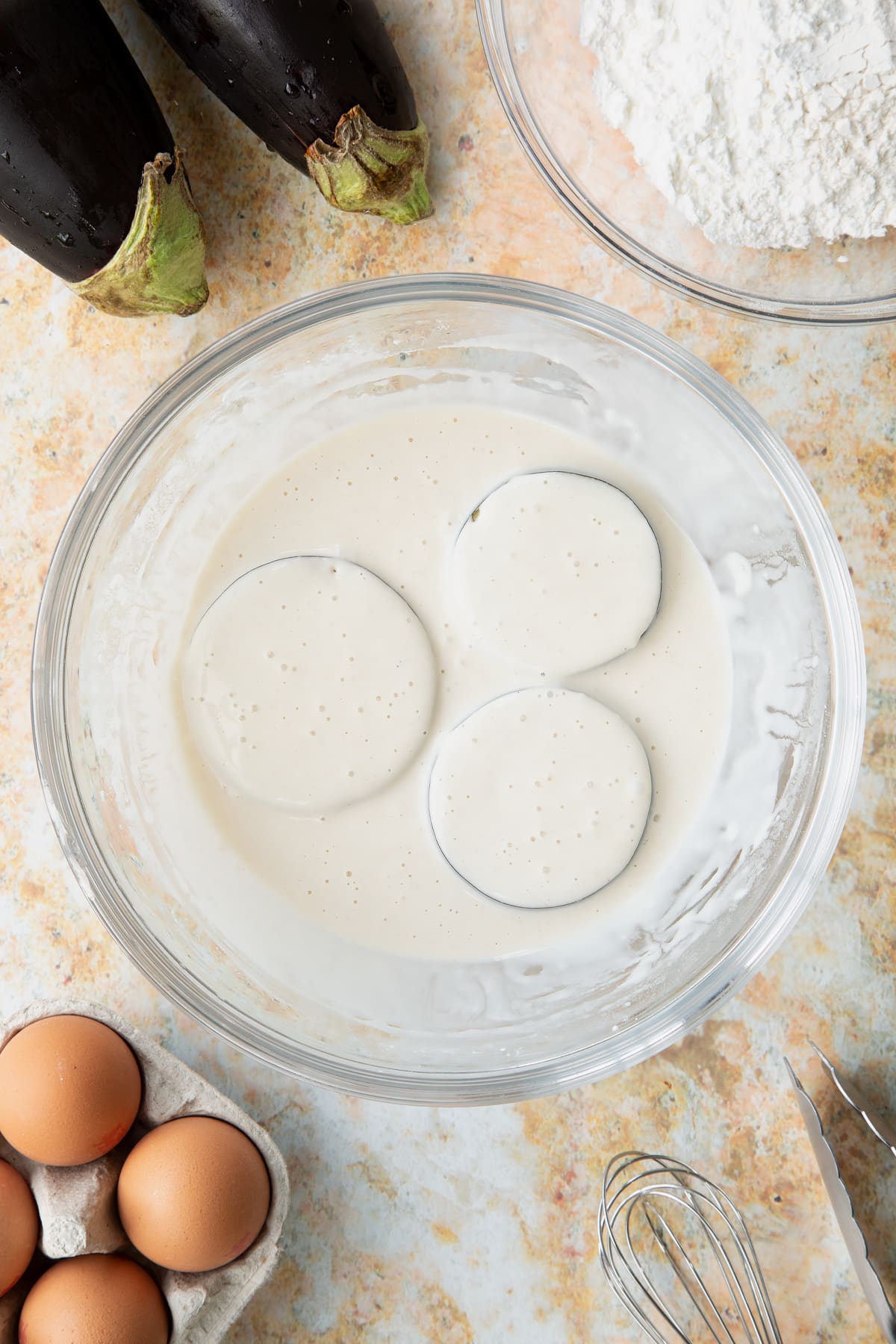
Fry for 3-4 minutes until very crispy and puffed, turning gently as needed. They shouldn't take on much colour.
Lift from the pan using a slotted spoon or straining spoon. Place on a plate lined with kitchen paper to allow the oil to drain.

If you like, you can place the drained tempura on a baking sheet in a low over to stay hot and crisp while you fry the rest of the batch.
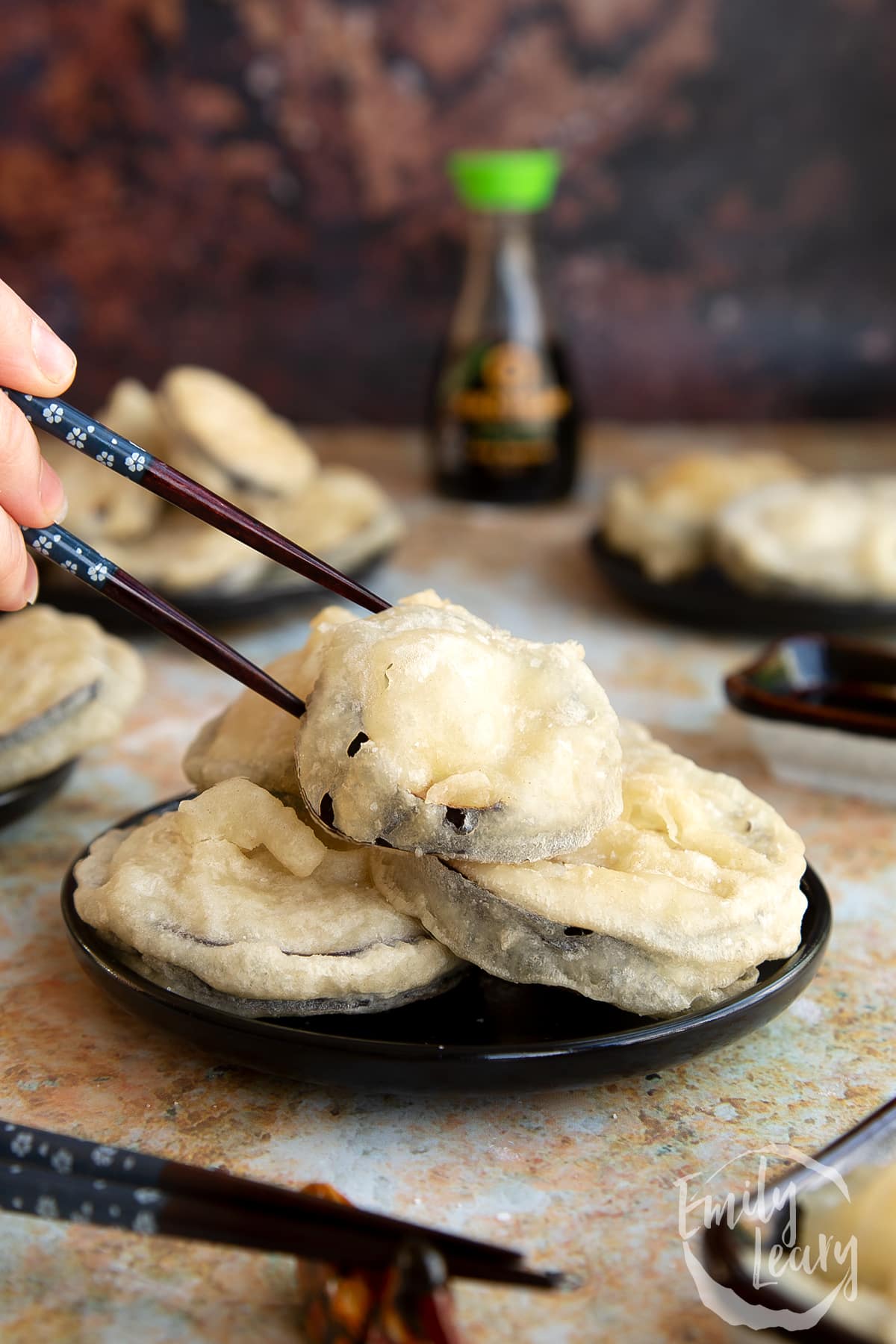
Enjoy your eggplant tempura!

Pointers, tricks and troubleshooting tips for the perfect Eggplant Tempura
Is Eggplant Tempura easy to make?
Eggplant Tempura is actually quite easy to make! The hardest part is probably slicing the eggplant thinly and evenly. Other than that, all you need to do is mix up a batter, coat the eggplant in it, and fry it until it's crispy and golden brown.
As with all of my recipes, I've included detailed step-by-step instructions and clear photos. So if you're ever confused along the way, you can see more detail in the section above this. Enjoy!
Will I need any special equipment to make this tempura recipe?
No, you don't need any special equipment. All you need is a mixing bowl, a whisk, a kitchen knife and chopping board, and a deep fat fryer or large saucepan.
There's always a complete list of suggested equipment on the recipe card below my recipes if you're in doubt.
I also always include links to example products, to show exactly what I used to make each recipe.
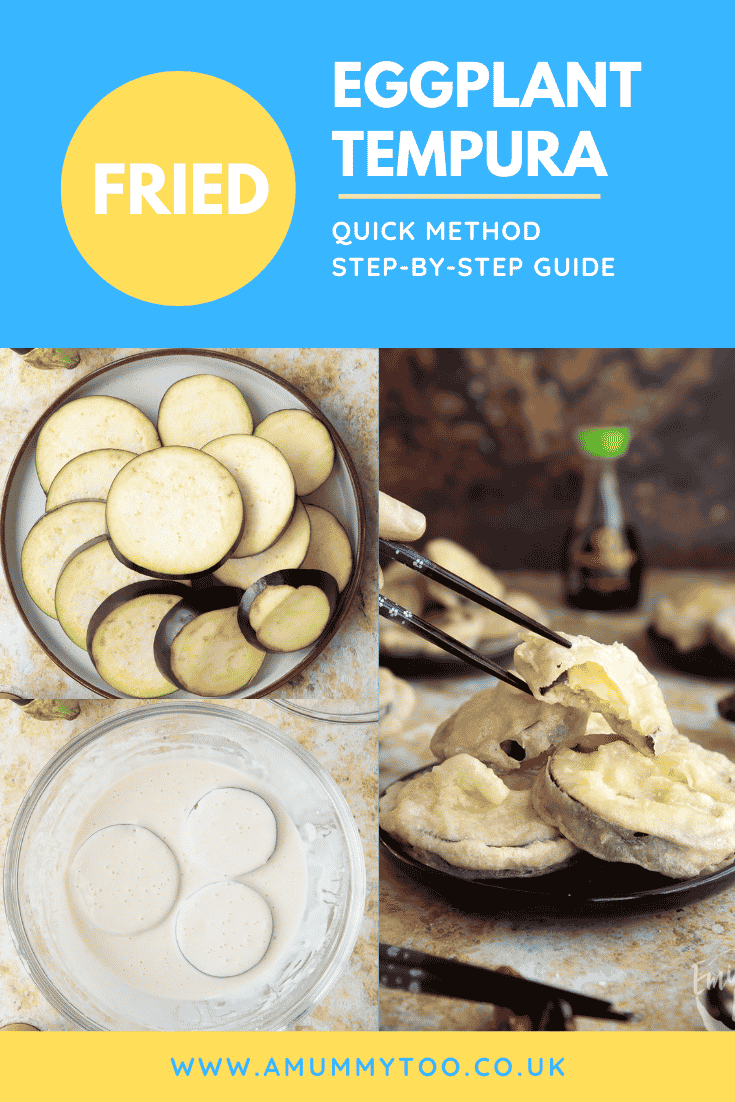
What kind of eggplant should I use?
There are many kinds of aubergine or eggplant, and you could use them all for this recipe but I would recommend using a medium purple aubergine/eggplant.
How can I tell if eggs have gone off?
If you're not sure whether your eggs are fresh enough to use, you can do a float test.
Simply place the egg in a bowl of cold water. If it sinks to the bottom and lies on its side, it's fresh and good to use. When an egg stands on one end at the bottom of the bowl, it's still good to use, but not quite as fresh. If it floats to the top of the bowl, it has gone off and you should not use it.
Is Eggplant Tempura suitable for vegetarians?
Yes, Eggplant Tempura is suitable for vegetarians as long as you use a vegetarian-friendly oil for frying.
Always make sure that you double-check all of your ingredients labels to ensure that they are vegetarian. Also, don't forget to check anything extra that you intend to serve with your Eggplant Tempura.
Is Eggplant Tempura suitable for vegans?
No, Eggplant Tempura is not suitable for vegans as it contains egg yolk. You could try skipping the egg yolk or using a powdered egg replacer in the batter instead.
I haven't tried this recipe without the egg in the batter, but it should turn out similarly as long as you use some sort of protein-based binding agent alternative to mimic the behaviour of the egg.
Manufacturers use non-vegan ingredients to thicken, colour or flavour sweet and savoury food. So make sure that you double-check all of your ingredients labels to ensure that they are vegetarian. Also, don't forget to check anything extra that you intend to serve with your tempura.

Are Eggplant Tempura gluten-free?
You can make Eggplant Tempura gluten-free by using gluten-free flour. This recipe uses equal parts cornflour (cornstarch) and wheat flour, so swap the wheat flour for an alternative.
Potato flour or rice flour could work well to replace wheat flour. Or you could use a gluten-free tempura mix.
Double-check all of your ingredients labels to make sure that they are gluten-free. Don't forget to check anything extra that you intend to serve with your tempura.
Is Eggplant Tempura keto-friendly?
Yes, Eggplant Tempura is keto-friendly as long as you use keto-friendly flour. Aubergines are relatively low in carbs per serving so they are suitable for a ketogenic diet in moderation.
So you only need to swap the 100g wheat flour and 100g cornflour with 200g of keto-friendly flour. Using keto flour will most likely change the texture of the batter, as keto flour tends to be low in starch. The starch from the cornflour is a key component in getting a crisp light batter, but unfortunately, it is not keto-friendly.
Is Eggplant Tempura suitable for those on a FODMAP diet?
No, Eggplant Tempura is not suitable for those on a FODMAP diet as Eggplant is high in FODMAPs.
If you are on a low-FODMAP diet, you can try making zucchini tempura instead of Eggplant. Courgette Tempura will cook a little quicker than aubergine, as it is smaller and has a softer texture.
Is Eggplant Tempura healthy?
This is a difficult question to answer as it depends on how you define "healthy". Eggplant Tempura is fried, so it is not as healthy as baked Eggplant
However, Eggplant Tempura is still a healthier fried option as it isn't coated in a thick batter, so should absorb less oil.
Is Eggplant Tempura safe to eat while pregnant?
Yes, Eggplant Tempura is safe to eat while pregnant as long as you cook it thoroughly.
Pregnant people should avoid undercooked meat, poultry and eggs as well as certain types of fish. Eggplant Tempura is cooked in oil until the eggplant is tender so it is safe to eat.
As with all fried foods, you should eat Eggplant Tempura in moderation as it is high in fat.
You should check with your GP or healthcare provider to make sure that any ingredients you are unsure of are safe to eat during pregnancy.
A Mummy Too does not give medical advice. If you have any questions or concerns please speak to a health professional.
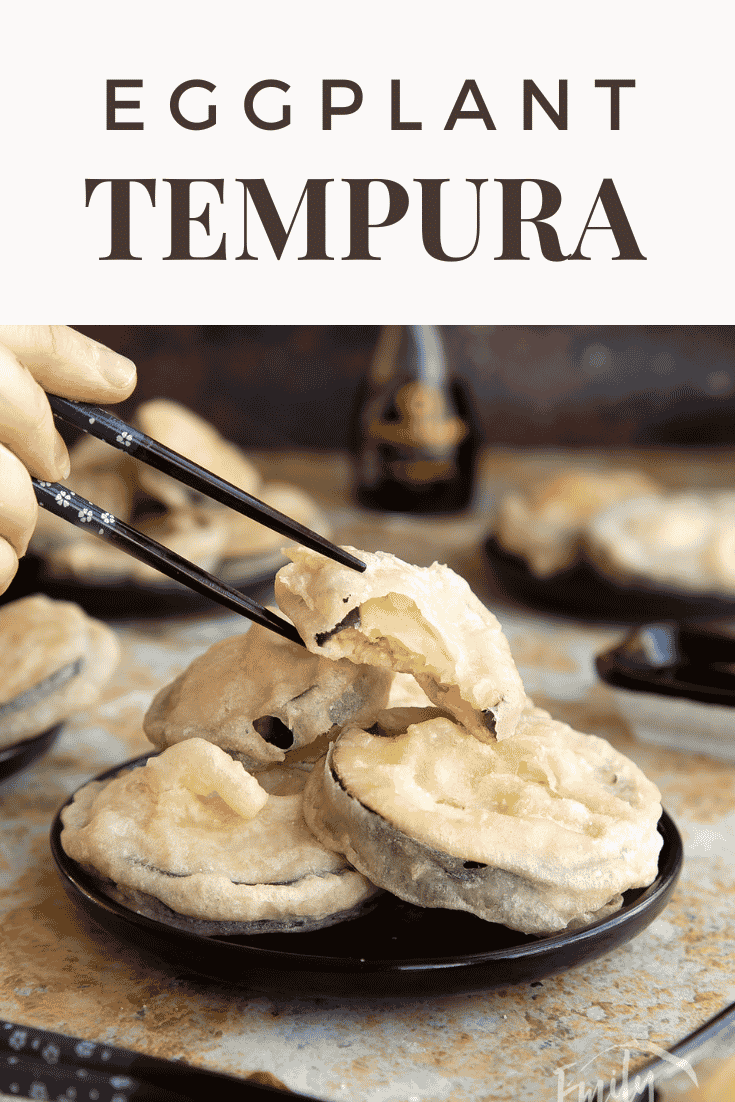
Is Eggplant Tempura suitable for babies and toddlers?
This recipe isn't suitable for babies or toddlers as it's deep-fried, contains salt and poses a choking risk.
A Mummy Too does not give medical advice. If you have any questions or concerns please speak to a health professional.
The NHS has some fantastic resources on their website on what to feed babies and young children.
What should I serve with Eggplant Tempura?
Eggplant Tempura is traditionally served with rice and dashi soup. However, I think this would make a great starter or a part of a table full of other Japanese snack dishes.
What can I use instead of eggplant?
If you can't find eggplant, then you could try using courgette (zucchini) or mushrooms. However, feel free to make tempura with any kind of vegetables that will cook in a few minutes. You could even use thinner slices of a root vegetable like sweet potato.
What can I use instead of cornflour?
If you want to make Eggplant Tempura without cornflour, then you could try using rice flour or potato flour. These will both work as binding agents and will help to create a crispy batter. This is because like cornflour, they are high in starch.
Tempura gets its crispy texture from the starch granules heating up, popping and setting into a crispy network within the coating. So using a high starch flour will work well.
If you're cooking this dish for someone who can't eat gluten, make sure you use a gluten-free alternative.
What are the best oils to use for tempura?
The best oils to use for tempura are rapeseed oil or peanut oil as they have a high smoking point. This means they can be heated to a high temperature without burning, making them ideal for deep-frying.
How should I store this tempura recipe?
This recipe is best eaten fresh. However, if you have any leftovers then you can store them in an airtight container in the fridge. Bear in mind they will become soggy after more than a couple of hours.
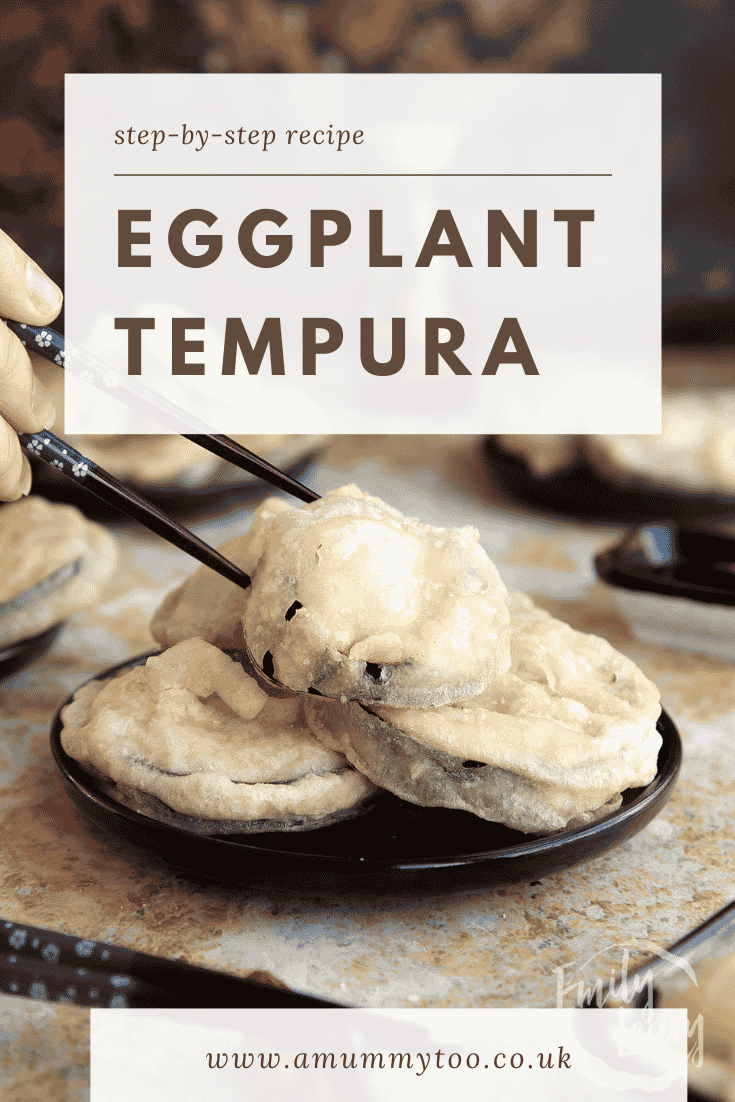
How long will Eggplant Tempura keep?
Your Eggplant Tempura should keep for up to 2 days, however, they will become soggier and soggier the longer you keep them. So where possible, it's best to enjoy them fresh.
Can I leave Eggplant Tempura out on the counter?
You can leave your tempura out on the counter to serve. Though once your meal is over, you'll need to refrigerate any leftovers.
Can I make Eggplant Tempura ahead?
In theory, yes. However, it's best if you eat this recipe fresh, as the moisture from the eggplant will seep into the batter and make it soggy. So if you're making this for dinner with friends or family, you should make it 'à la minute' (that's French chef speak for 'when you want to serve it.')
Can I keep Eggplant Tempura in the refrigerator?
Yes, Eggplant Tempura will keep in the fridge for up to 2 days. However, the tempura batter will become soggy over time so it's best to eat it fresh if you can.
Can I freeze this tempura recipe?
This recipe isn't suitable for freezing, as the eggplant will become super mushy once you defrost it. Plus, the tempura batter will become soggy or disintegrate.
Can I make this Eggplant Tempura in a different quantity?
Sure! The pieces of Eggplant Tempura cook individually, so as long as you make some extra batter you can make more. Or you can use less aubergine
Why do you use fizzy water in tempura batter?
The carbon dioxide in fizzy water helps to create a lighter, crispier tempura batter. If you don't have any fizzy water, then you could use sparkling mineral water or even make your own by adding a teaspoon of baking soda (bicarbonate of soda) to still water.
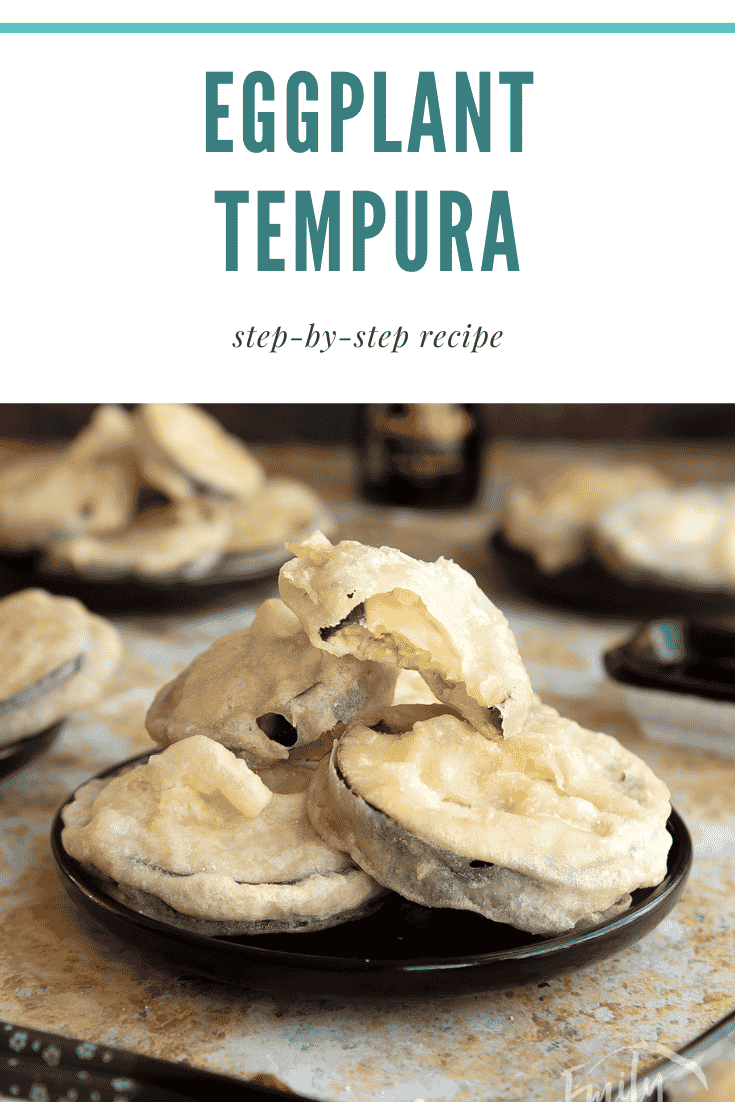
Why does water have to be ice cold in tempura batter?
When you add water to the flour, it forms a gluten network. Gluten is what gives bread its structure.
If you use too much water or if the water is warm, then this gluten network will become tough and chewy. However, cold temperatures delay the gluten network forming.
So using ice-cold water helps to prevent this from happening and makes for a light and crispy batter, rather than a chewy one.
How do I make sure my tempura batter is of perfect consistency?
The key to the perfect tempura batter is to get the ratio of flour to liquid right. Too much flour and your batter will be too thick and will result in heavy, greasy tempura. Too much liquid and your batter will be too thin and will result in light, airy tempura.
The best way to get a perfect consistency is to weigh your ingredients. I would recommend using a kitchen scale to measure out 100g of flour and 100ml of water, as cups can be imprecise.
If you don't have a kitchen scale, you can use cups - just make sure to carefully level off the cup of flour with a knife so that you don't end up with too much or too little.
Once you have your ingredients measured out, simply whisk them together until you have a smooth batter.
Can I make Eggplant Tempura in a stand mixer such as a KitchenAid or Kenwood Mixer?
Yes, you could use a stand mixer with the balloon whisk attachment. An electric whisk will help get lots of air into the batter, which is important as there is no baking soda or raising agent. Using an electric whisk also helps to ensure your batter is nice and smooth.
Can I make Eggplant Tempura with a food processor?
Nah! There's no point in this recipe that would require a food processor. So save the blender for soup and whisk by hand or with a stand mixer.
How can I make sure my Eggplant Tempura turn out perfectly?
There are a few key things to remember when making Eggplant Tempura:
- Use a high smoking point oil such as rapeseed or peanut oil - this will help to ensure your tempura doesn't burn. Though you should bear in mind peanut oil isn't suitable for people with nut allergies.
- Make sure your batter is of the right consistency - too thick and it will be greasy, too thin and it won't cling to the aubergine as well.
- Don't overcrowd your bowl - adding all the aubergine slices at once to the batter will dilute it with extra water content.
- Don't overcrowd your pan - you should only cook a few pieces of Eggplant Tempura at a time so that they have enough space to crisp up.
- Make sure you really coat your eggplant in the batter - this will help them to cook evenly and prevent the eggplant from drying out.
- Cook your Eggplant Tempura until they're golden brown - this will ensure they're cooked through but still soft and fluffy on the inside.
Why did my Eggplant Tempura burn?
There are a few reasons why your Eggplant Tempura might have turned out dry or burned.
The most obvious answer is that you overcooked them or the temperature was too high. You should cook Eggplant Tempura until they're golden brown. So if you cook them for too long, they will dry out and become burnt.
However, your tempura will also burn if you don't use enough oil. Eggplant Tempura needs to be deep-fried, not pan-fried. This means you should be able to fully submerge them in hot oil so that they can crisp up.
If you don't use enough oil, the batter can slide off the aubergine. This will most likely cause areas to stick to the pan and burn before other areas cook.
Why did my Eggplant Tempura turn out wet/soft?
Aubergine is very soft when it is cooked, so the inside should be soft, and maybe even what you would consider wet.
How can I add/change the flavours in this tempura recipe?
There are a few ways you can change up the flavours in this Eggplant Tempura recipe:
- Try using a different type of flour -coconut flour instead of wheat flour could impart some extra flavour and new texture to your tempura.
- Add some garlic powder or onion powder to the batter for a more savoury flavour.
- Add some Japanese flavourings like togarashi mix or crushed nori flakes to the batter, or sprinkle them over the top.
- Or, a tablespoon of Chinese Five Spice would complement the flavour of aubergine.
Who invented tempura?
You may think that Tempura is a Japanese invention, but it was actually created by the Portuguese!
The word tempura is derived from the Latin word 'tempora', which refers to the Ember days when Catholics were traditionally not supposed to eat meat
So, originally, tempura was a type of fried vegetable dish that was created as a way to comply with this religious rule
Portuguese explorers and traders were the first Europeans to visit and make contact with Japan, in 1543. So they probably introduced battered, deep-fried vegetables to Japan in the 16th century.
Print this Eggplant Tempura recipe
Eggplant Tempura Recipe
Ingredients
- 2 eggplants (aubergine) cut into 2cm (1/2 inch) slices
- 100 g plain white flour (all purpose flour)
- 100 g cornflour (cornstarch)
- pinch salt
- 1 medium free range egg yolk chilled
- 200 ml fizzy water chilled
- vegetable oil to fry
Equipment
- Deep fat fryer or suitable high-sided saucepan or suitably large, high-sided saucepan
Instructions
- Your fizzy water needs to be icy cold, so either chill it in a container in the refrigerator overnight, or pop a container in freezer while you get organised.
- Fill your deep fat fryer (or a suitably large and high-sided saucepan) to one third full with oil. It's important not to overfill your fryer as oil expands when heated and can bubble up further when food is added. Heat to 180C (355F). Keep your oil supervised at all times.
- Get your eggplant / aubergine sliced into discs so that they're on hand to use as soon as your batter is ready, cover so that they don't brown.
- Put the flour, cornflour and a pinch of salt in a bowl. Mix together.
- Add the egg yolk and chilled fizzy water. Whisk until you have a smooth batter. Whisking in one direction only can help avoid lumps.
- Drop a few pieces of eggplant / aubergine into the batter. Make sure to coat all over, then lower straight into the oil. Don’t drop all the veggies into the batter at once as they can change the temperature and thickness of the batter if they sit in it too long. You also need to work in batches so that you don’t overcrowd the frying pan.
- Fry for 3-4 minutes until very crispy and puffed, turning gently as needed. They shouldn't take on much colour.
- Lift from the pan using a slotted spoon or straining spoon. Place on a plate lined with kitchen paper to allow the oil to drain.
- If you like, you can place the drained tempura on a baking sheet in a low over to stay hot and crisp while you fry the rest of the batch.
- Enjoy your eggplant tempura!
Video
Nutrition
Pin this Eggplant Tempura recipe

More aubergine recipes to try
Have you got my book?

'This is a great kids cookery book. Emily is a star' - Simon Rimmer
'The book I'd like to force into any mother's kitchen' - Prue Leith
"A fab book with a plan." - Jane Devonshire, 2016 Masterchef UK winner
'Emily has managed to combine her mummy knowledge and passion for food to make a truly helpful and brilliant cookbook' - Priya Tew, RD, BSc (Hons), Msc
Get Your Kids to Eat Anything is an achievable 'how to' for parents in the battle to overcome picky eating and 'make new the norm'. Emily Leary's unique 5-phase programme looks at the issue of 'fussy eating' in a holistic way that links imagination with food, and which situates parents alongside - not in opposition to - their children.
.

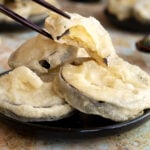



Leave a Reply